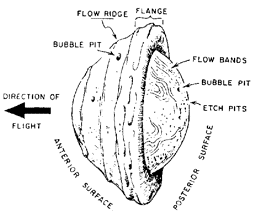 |
Science Frontiers ONLINE No. 78: Nov-Dec 1991 |
|
|
Heavy bombardment of southeast asia 700,000 years ago
Tektites are found all over much of Australasia -- an immense area. The tiny, often-illustrated teardrop- and button-shaped tektites clearly seem to have been formed when an extraterrestrial object smashed into the earth, melted terrestrial rock and soil, and splashed the fluid droplets over thousands of kilometers of Australia and Southeast Asia. Solidifying in flight, these par-ticles fell by the millions.
 Aerodynamically sculpted Australasian tektite |
Since layered tektites are found over an area 800 x 1140 kilometers in extent, and they are not far-travelers, Southeast Asia must have been peppered with many small cosmic projectiles 700,000 years ago (the disputed age of the event). Whereas geologists have been searching diligently for a single huge crater (perhaps 100 kilometers in diameter) to explain the Australasia strewn field, they should be looking for many 1-kilometer craters.
This scenario is radically different from mainstream thinking about this great event in earth history. (Wasson, John T.; "Layered Tektites: A Multiple Impact Origin for the Australasian Tektites," Journal of Geophysical Research, 102:95, 1991.)
Reference. For more on tektites, see ESM3 in the catalog Neglected Geological Anomalies. For details, visit: here.